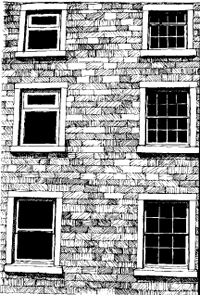Historic windows

 Windows are the eyes of a building and may be its most characterful feature. Altering them can easily spoil not just the building but the character of a whole area.
Windows are the eyes of a building and may be its most characterful feature. Altering them can easily spoil not just the building but the character of a whole area.
Unsympathetic window replacements can affect not just the character but the financial value of the property. Buildings which retain their traditional appearance are increasingly sought after. Most historic windows can be repaired. Too often they are needlessly replaced.
There are various types of traditional window within the National Park. Their design, material and method of opening have all varied over the centuries. Most types of modern window such as UPVC, "storm proofed" casements or "top hinged" windows will almost always look wrong in old buildings.
The advice is usually to:
- Retain original windows, repairing wherever possible
- Renew, if necessary, with exact replicas
- Avoid modern-style windows
- To improve thermal efficiency, draught strip existing windows or add secondary glazing.
Repair
Repairing original windows is the best way of conserving the character of the building. It retains historic fabric, not just the joinery but also the original glass. In most cases the timber is of better quality than today's replacement. It is often only the bottom sill and lower portions of the frames which tend to rot and therefore need replacement. Properly repaired and maintained original windows can give service for 100, 150 or 200 years. Such windows are more cost effective in the long term than replacement with modern alternatives.
Renewal
Where replacement of original windows is unavoidable, the new window should be an exact copy of the original. This means not just the same design, material and method of opening, but the same mouldings and thicknesses for frames and glazing bars. It is particularly important that the glazing bars are no thicker than the originals – usually about 18mm.
Alterations and additional windows

Using a modern style of window is not appropriate in historic buildings. New windows should:
- Open in a traditional manner – i.e. "Yorkshire" sashes, vertically sliding sashes or side hung casements for houses; occasionally, inward opening hoppers in agricultural buildings. Top hung, outward opening lights, louvres or pivot windows are generally unsuitable.
- Be subdivided in a traditional manner – this generally means each individual pane is related to the proportions of the window as a whole. Un-subdivided or poorly subdivided windows are not acceptable.
- Be traditionally detailed i.e. with flush frames not storm proof detailing in the case of side hung casements, and with correctly profiled mouldings to the frames and glazing bars.
Finishes
To retain their historic character, windows should have a paint or opaque finish – preferably white or off-white, as these tend to be the predominant colours. A transparent brown timber stain is not appropriate on historic houses, because historically external joinery was almost always painted to preserve it.
Glass
Old glass, especially crown glass, has a sparkling reflective quality entirely lacking in modern float glass with its uniform, flat appearance. Wherever possible, original glass should be saved for reuse. It adds considerably to the attractiveness of a property. Some specialist firms now produce reproduction glass specifically for use in historic buildings.
Double glazing
Please think twice before replacing windows with double glazed units, whether in UPVC, aluminium or timber frames. The sizeable investment needed for such replacements is rarely reflected in the value of the property. Installing such windows in an historic building can in fact reduce its value.
There is growing evidence that UPVC or aluminium windows are not cheaper in the long run, despite the maintenance-free claims made for them.
Old buildings need to 'breathe'. Eliminating all air currents can lead to condensation problems in hidden parts of the structure. Ecologically, the use of UPVC in particular is damaging both in terms of the energy needed for manufacture and the problems associated with its disposal.
It is possible to achieve improved thermal insulation and reduce draughts by overhauling and upgrading existing windows. Specialist firms can provide some of the advantages of double glazing without the expense, disruption and damage to the character of the property. We can offer information on such firms.
Adding secondary glazing is another option which in historic building terms is normally preferable to double glazed units. Secondary glazing is also a more effective way of providing sound insulation, because of the wider air gap between the two sheets of glass.
The last argument against double glazing is of course the aesthetic one. Unless special care is taken, the material, frame thickness, mouldings, glazing bars and glass all look wrong in an historic building.
The Authority is likely to refuse all applications to install UPVC windows in listed buildings.
Permissions
If your property is listed, then Listed Building Consent is needed for any alteration to the existing windows. Changing the material, from timber to UPVC for instance, is an alteration which requires consent. If your property is not listed, depending on its use you may require planning permission to alter the windows. You should check with the planners in the Planning Service of the Authority. If you are replacing windows you will either need building regulations approval from your District Council or you will need to have the new windows installed by a FENSA registered contractor. This is separate from any planning requirement.
Further advice
If you would like further advice on any aspects of traditional windows please contact a Conservation Officer using the contact details below.
If your building is not in the National Park please contact your local authority.
Peak District National Park Authority
Aldern House, Baslow Road, Bakewell, Derbyshire DE45 1AE
Telephone: 01629 816200
Email: customer.service@peakdistrict.gov.uk

